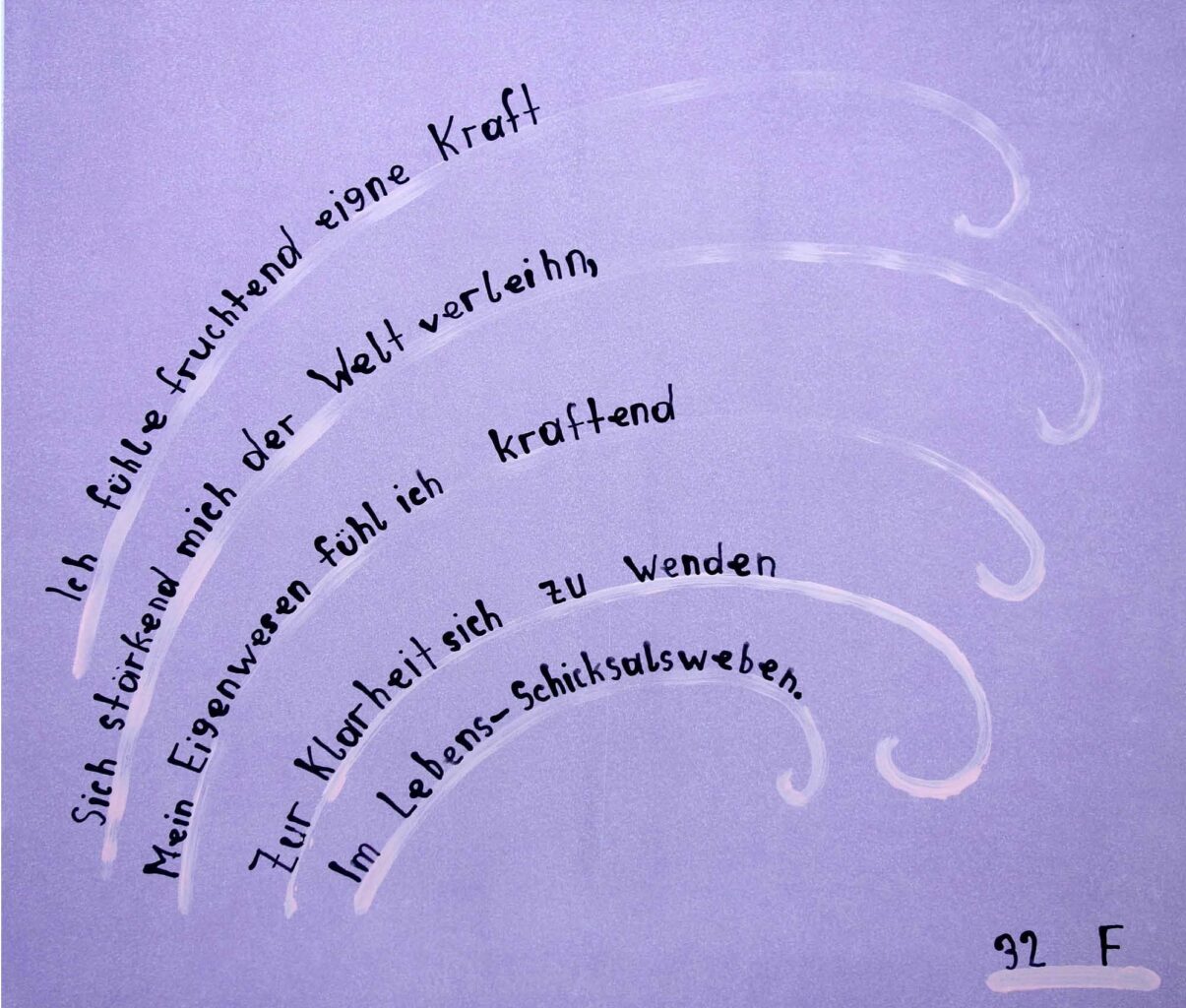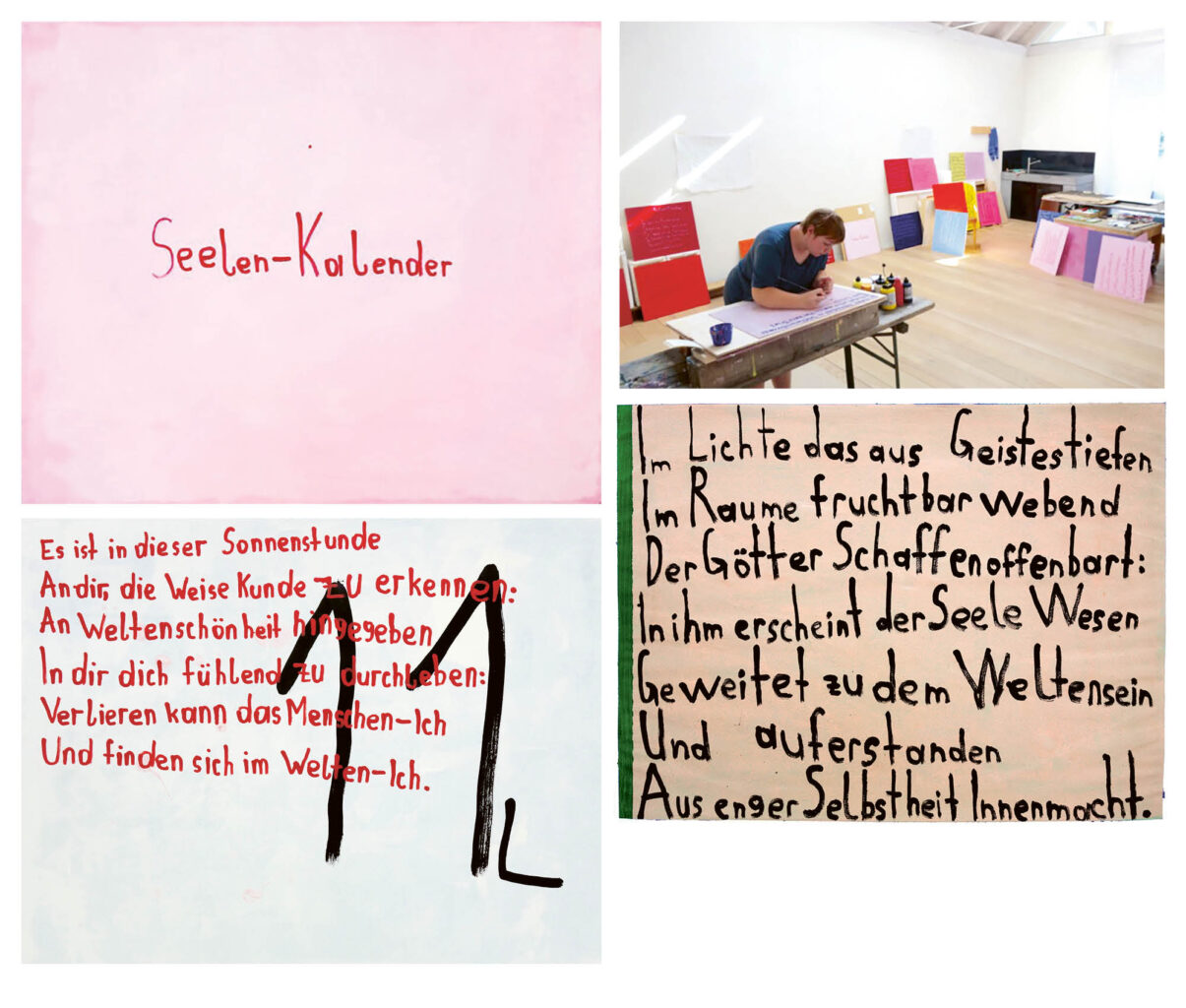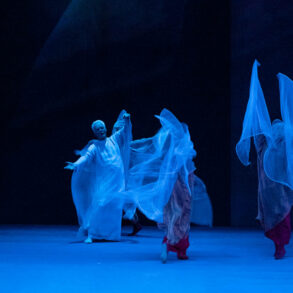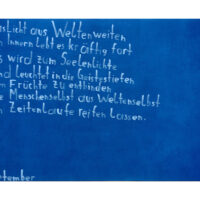For three years, Victoria Öttl has been painting the verses of the Soul Calendar. Her works will be on display in October at the Goetheanum’s international conference, celebrating the one-hundredth anniversary of Rudolf Steiner’s Education for Special Needs course and the founding of the twelfth Section of the School of Spiritual Science, the Section for Inclusive Social Development. The artist Hannes Weigert has accompanied her and offers insights into their collaborative work.

The Painting Studio [Malerei] is located at Loidholdhof,1 above the Danube, in Upper Austria. In this region, the word “painting” [Malerei] refers not only to a form of art but is also used to describe a painting workshop. In this comprehensive sense, painting at Loidholdhof includes the whole world of craftsmanship. This includes what is written and the act of writing itself, in particular, the writing of the Soul Calendar verses by Victoria Öttl.
It started like this [according to Victoria]: “I wrote ‘Ronja the Robber’s Daughter’ on a piece of paper for my friend Vivian. He left it by the coffee machine. A short time later, the painting master, Hannes Weigert, found it. He thought, ‘Who wrote that?’ (Since I had written it so beautifully.) I went back and said, ‘It was me!’ We thought about what we could do with this writing, and that’s when we came to the decision to write out the Soul Calendar verses.”2
On February 23, 2021, Victoria wrote the verse that begins, “In the light from out of world heights . . .” [Verse 48] with a brush and black paint on a large sheet of paper that I had first primed in color (“You prepared the plates. You painted the background, always different.”) We showed the verse the next day in the morning circle: “we all get together every morning and look at what’s coming up for the day. And that’s when we read the verse. I read the verse. And the written panels are there; not all of them, just the ones with the verse I’m reading.”
Over the course of three years, three versions of the verses were created. Looking back, Victoria writes: “I transferred the verses to the panels. I read the verses. I wrote down thoughts about the verses. By speaking, thoughts about the verses came to light.”
Learning to Feel
Hannes: Do you want to say something else about the verses?
Victoria: The verses were coined by Rudolf Steiner. He then wrote them down in a book.
What are the verses about?
The life of the ‘I.’
About the life of the ‘I’ in the course of the year? Indeed, it changes all the time.
Exactly. On the one hand, the verses have to do with me; on the other hand, they have a lot to do with the outside, with the world; with how the plants germinate, ripen, bear fruit . . . how [nature] changes from spring to winter, one could say.
And in winter?
And in winter, everything is bare outside.
In the soul, too?
Then everything blossoms in the soul (laughs). I don’t know exactly how else to describe it.3
Morning, at the Painting Studio
Victoria came to write. Today, she only wrote the first two words of the spring verse on a plate: “Into inwardness” [Verse 51]. Then, she sat down at the table and thought about what she wanted to write down today. She remembered how we had run into each other over by the stable a few weeks ago and how she had said to me that she felt such a strong connection with the verses. She wanted to write that down today. After she had already written something, she paused and said to me, “I was really deep in thought just now, I have to say, honestly.” Then she continued, “By reading the verses every day, I’m getting a connection with them. One time this week, when writing the verses, I really immersed myself in the verse and really thought about it. I really went into myself. Everything else, outside of me, was completely forgotten.”4

Top right: Victoria Öttl writing, 2022
Bottom left: Panel #136, 2023
Bottom right: Panel #10, 2021
In Every Verse, There’s the ‘I’
In our conversations over the past year, which followed her writing, “thoughts came to light,” which she then often wrote down verbatim as they had come out of her mouth a moment before:5
(Verse 2) The human being matures. Hannes asks: Is there inner growth of the soul? I answer: There really should be. When have you reached your goal?
(3) It’s Konrad’s birthday today, and I’m going to ask him what the “primal state” [Urstand] is. Where is the ‘I’ at home?
(5) The soul’s being—do you know what that can be? The inner being! It’s in the word; in reading the verse, it sprung out at me. It’s fascinating when thoughts come to you while reading.
(6) Archetype is something that happened a long time ago. I can’t really think of anything more. Does the archetypal picture say “my self” to itself?
(8) Is thinking a sense?
(9) What’s all this about losing? Is the premonition [Ahnung] like a self-remembering? (Now, I just distracted myself.)
(17) I can’t see the World Word with my eyes. Did I say something stupid there? I believe not. Then how does it get through the senses’ door into the grounds of the soul?
(18) You put on a dress. The soul is the dress. The spirit should put it on. I am the tailor.
(24) To be honest, I don’t exactly know how the soul-being should become aware of herself. Does this have anything to do with creating? Is it that the soul-being creates herself and becomes aware of herself in the creating?
(26) Michaelmas mood. The verse is really very puzzling quite honestly. The whole mood, the whole harmony, somehow.
(27) Does that mean me there, as a being? The soul belongs, in some way, to the being, I believe. I am the being that observes itself, yes?
(28) The ‘I’ is present in every verse. Even when the word ‘I’ is not in the verse, the ‘I’ is inwardly present everywhere. I was already struck by this in the last verses, so I thought to myself that I had to observe how it further develops throughout all the verses.
(32) In the weaving of life’s destiny. I intuited the eurythmy form for this. The lines go up and down. They go back and forth, they penetrate each other, they are interwoven. Is the ‘I’ in there?
(33) I’m just thinking about it. What can that mean? Do I have to feel the knowing?
(34) What is he writing here? I can’t do anything with it—the verse is puzzling to me.
(37) It’s really crazy what ideas come to me. I thought to myself: the spiritual light must actually be inside of me. I believe that I know what the word “strive” means.
(45) It’s darker in winter than in summer. Good thoughts are brighter than bad thoughts.
(49) The night is within. From there, hope streams out.
(50) The birth of the human ‘I’ out of the world existence is my true aim. Then the magic spell will be broken!
(51) The eye is a mirror. It mirrors the world. “He” is the spirit of the world. That’s amazing: That the spirit of the world is in the reflection of the human eye.
(52) The spirit inside you. The beauty wells up, like when the sun shines into the Danube. There is one spirit that turns inward and one that turns outward. Oh, that I could express how the two are connected!
The Painting Studio has been around since 2018, picking up where I left off with the Painter’s Workshop [Malerverksted] in Vidaråsen6 and the Painting Workshop [Malerwerkstatt] at the Goetheanum.7 In addition to the collaboration with Victoria Öttl and my own painting research and practice, there are other projects in painting. These include: Developing a School for Aesthetic Practice with Bodo von Plato8, accompanying the painter Kathrin Sammer in her study of Steiner’s painting sketches, delving deeper into the mantras of the class lessons with Joachim Eckl, and the painting collaboration with Julia Weinknecht.9 In addition, seminars10 and exhibitions are held (as part of the Free Academy at Loidholdhof), and publications are also issued.11
Conference Info
Inclusive Social Development: Celebrating 100 Years Together!, Oct. 2–6, 2024, Goetheanum, Dornach
Panels for the Soul Calendar Victoria Öttl (writing), Hannes Weigert (concept/colour), acrylic on hardboard, 50 × 60/65 cm. The Painting Studio, 2021-23
Translation Joshua Kelberman
Title image Panel #141, 2023
Footnotes
- The Loidholdhof is an integrative farm community; www.loidholdhof.at.
- Interview of Victoria Öttl by Hannes Weigert, Nov. 16, 2023; cf. Hannes Weigert, “Learning to Feel,” Anthroposophic Perspectives in Inclusive Social Development, no. 2 (2024): 34–37.
- Ibid.
- Hannes Weigert, Private Records, March 20, 2023; cf. Achim Leibing, “Panels for the Soul Calendar,” Anthroposophic Perspectives in Inclusive Social Development, no. 2 (2024): 22–27.
- Victoria Öttl and Hannes Weigert, Soul Calendar, Goetheanum, Dornach, Switzerland, Oct. 2–6, 2024.
- Painter’s Workshop [Malerverksted] (2010–2017); see Johannes Nilo, “Rätsel der Malerei“ [Riddles of Painting], Das Goetheanum, no 48 (Dec. 1, 2012).
- Painting Workshop [Malerwerkstatt] at the Goetheanum on Steiner’s designs for painting (with Miriam Wahl, 2017); see Gilda Rhien, “Skizzenbewusstsein” [Sketch Consciousness], Das Goetheanum, nos. 52–53 (2017).
- Bodo von Plato, ”Serious and Cheerful, at the Same Time” Goetheanum Weekly, Issue 2022/3-4.
- Julia Weinknecht and Hannes Weigert, “Elohim. Malerei im Anfang,” Freie Akademie Loidholdhof, June 21–23, 2024.
- Bodo von Plato and Hannes Weigert, “Denken und Sehen: Versuche zur Ästhetischen Praxis” [Thinking and Seeing: Experiments in aesthetic practice], Freie Akademie Loidholdhof, Sep. 20–22, 2024.
- Hannes Weigert, ed., Das Bewusstsein der Malerei. Ensemble 1 [The Consciousness of Painting. Ensemble 1] (Loidholdhof 2021); see Stephan Stockmar, “Dazwischen sein” [Being in between], Das Goetheanum 27–28 (2021). In preparation: Hannes Weigert, with contributions from Alexander Schaumann, Victoria Öttl, Achim Leibing, and others, Versuche zur Ästhetischen Praxis. Ensemble 2 [Experiments in Aesthetic Practice. Ensemble 2].










I joined the Anthroposophical Society February 1973,and the First Class April 1983. I attended Emerson College 1973-1976. I worked at Dorfgemeinschaft Hermansberg and at Hohepa Homes in New Zealand (my brother was the founding student.)